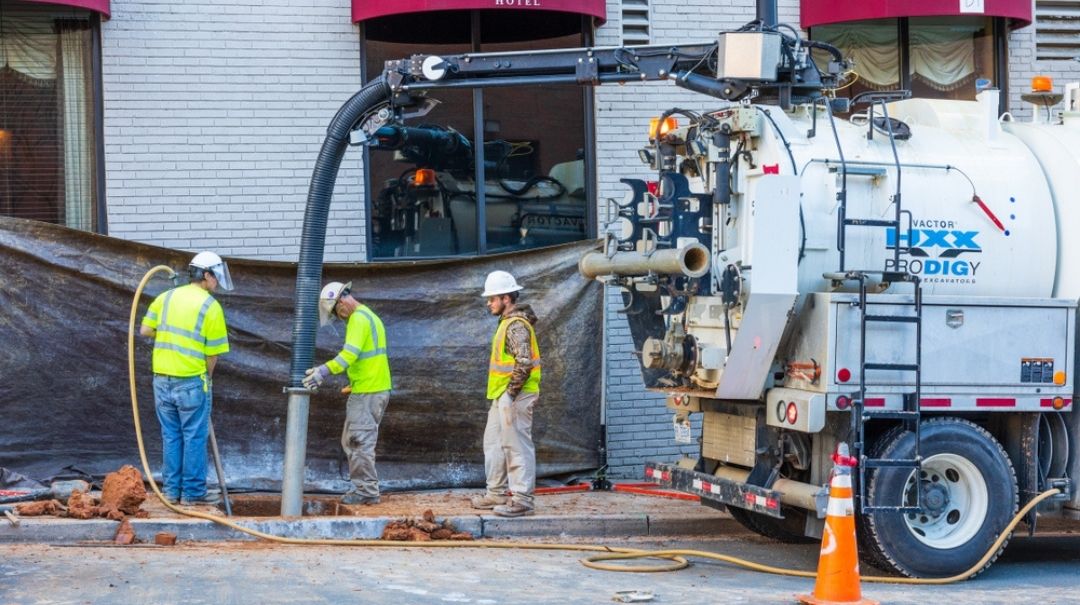There are many different ways to clear away soil and sediment from a job site. However, many of these methods are highly invasive and expensive, making them a poor fit for certain types of projects.
If you’re looking for a minimally-invasive way to clear away material from your job site, then vacuum excavation could be your solution.
Table of Contents
Understanding Vacuum Excavation
Vacuum excavation is a special type of excavation designed to be minimally invasive. It involves using a vacuum excavator to remove unwanted materials from the ground, such as:
- Dirt
- Mud
- Slurry
The strategy is very precise and controlled, making it an excellent choice for projects requiring a careful touch.
Hydro Excavation vs. Air Excavation: What’s the Difference?
As you research this technique, you’ll notice there are two main ways to do it:
- hydro vacuum excavation and
- air vacuum excavation.
Let’s look at what distinguishes these from one another.
What is hydro excavation?
Hydro vacuum excavation involves combining a vacuum with a highly-pressurized water supply. The water gets shot into the ground to loosen the soil up, and then the vacuum sucks the loose soil out of the ground.
Hydro excavation is faster than air excavation. It may also be a better option for plots of land with tough soil since the water is pressurized enough to cut through almost any type of dirt.
The downside to hydro excavation is that, when you use it, you can’t put the same material that you suck out back into the earth. That’s because the dirt becomes soft and wet, so it isn’t suitable to go back into the land after excavating it.
What is air excavation?
Air excavation gets rid of the water and uses compressed air to loosen up the soil and suck it out of the ground. It’s a method that’s considered safer than hydro excavation and one that allows you to refill whatever hole you create with the same material that you pulled out of it.
Although hydro excavation is more powerful and faster, air excavation could still be the right selection for some excavation projects.
How Does Vacuum Excavation Work?
Companies make specialized trucks to perform vacuum excavation jobs. These have both a compressor and a vacuum system mounted onboard. That way, the truck is all you need to break up the soil and pull it out of the earth.
The rest of this explanation depends on whether you’re using hydro vacuum excavation or air excavation.
If you’re using hydro excavation, the truck will shoot pressurized water into the ground and pull out the wet earth that remains.
If you’re using air excavation, the truck will shoot pressured air streams into the air and pull out the dry earth that it loosens.
Benefits of Vacuum Excavation
Hiring a vacuum excavation truck can be very beneficial to your project. Here are a few of the unique ways that it can help you out.
Avoid unwanted damage
Unwanted damage is probably the most common reason why companies hire vacuum excavation services. Unlike most other excavation techniques, vacuum excavation lets you clear away the dirt you no longer need without risking damaging unseen utility lines and other underground hazards.
So if you’re working on a patch of land that you assume has utility lines buried somewhere underneath it, then vacuum excavation could be your best way to clear out unwanted soil.
Improve speed while reducing cost
Another benefit of this technique is that vacuum excavation is typically much faster and much more cost-effective than other excavation techniques.
That’s because you don’t need a ton of machinery to perform this strategy. All you need to do is hire a vacuum excavation truck to come out to your job site, and it’ll take care of the whole excavation process for you.
Air excavation lets you refill the hole that you make with the same material
Sometimes you need to refill the holes that you create when you excavate. If you use most strategies, then you have to do the refilling with newly-purchased soil.
But if you use air excavation, you can reuse the soil that you pull up to refill whatever hole you create. That eliminates an expense from your project, which could’ve ended up being quite costly.
Very good at revealing the precise locations of utility lines
Sometimes the goal of an excavation project is simply to learn where the utility lines are on a plot of land. Vacuum excavation is perhaps the best way to achieve this goal.
It’s a very safe method of excavation. So you don’t have to worry about accidentally damaging the utility lines while you search for them.
Can Vacuum Excavation Help Your Project?
Should you use vacuum excavation on your next project or not?
The answer depends on the nature of the work.
Do you need to be careful about not disturbing the land too much? Or do you expect that there are utility lines buried underneath a plot of land that you absolutely don’t want to damage? If you answered yes to either of these questions, then vacuum excavation could be the right strategy for you.
However, it’s not the perfect option for every project. Vacuum excavation isn’t powerful enough to break through rocks or other types of dense underground materials, and it’s really only a strategy that can work on the soil.
So if your project is taking place on some land that’s full of tough rocks, then vacuum excavation may not be the right option for it. Instead, you may need to use another type of excavation to accomplish your goals for the project.
